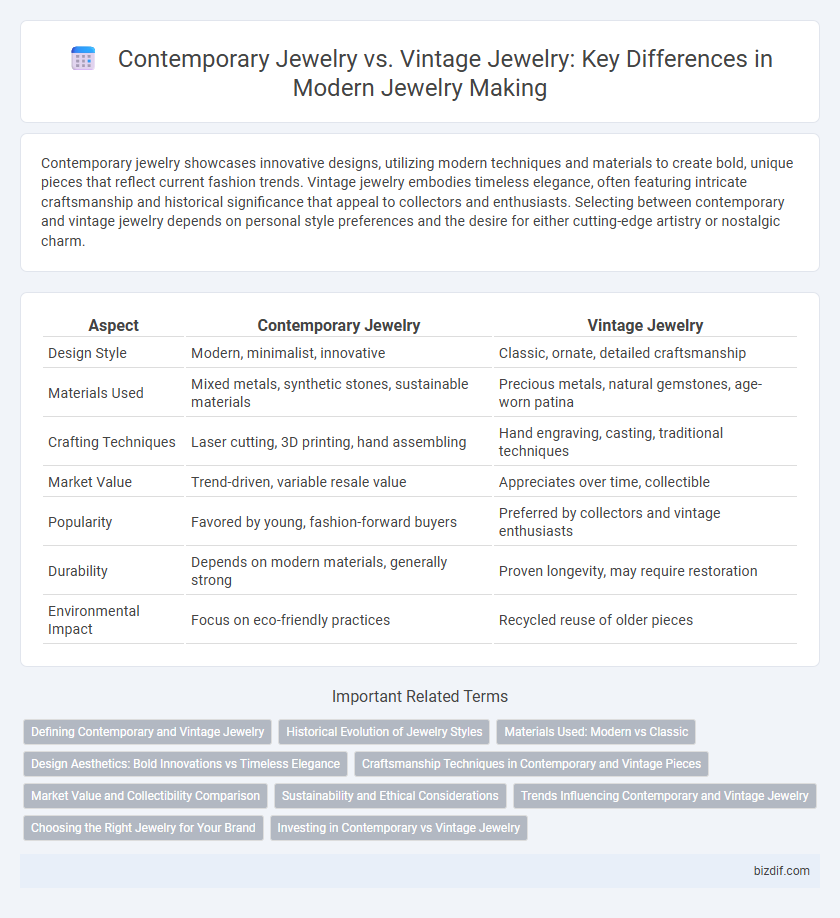Contemporary jewelry showcases innovative designs, utilizing modern techniques and materials to create bold, unique pieces that reflect current fashion trends. Vintage jewelry embodies timeless elegance, often featuring intricate craftsmanship and historical significance that appeal to collectors and enthusiasts. Selecting between contemporary and vintage jewelry depends on personal style preferences and the desire for either cutting-edge artistry or nostalgic charm.
Table of Comparison
| Aspect | Contemporary Jewelry | Vintage Jewelry |
|---|---|---|
| Design Style | Modern, minimalist, innovative | Classic, ornate, detailed craftsmanship |
| Materials Used | Mixed metals, synthetic stones, sustainable materials | Precious metals, natural gemstones, age-worn patina |
| Crafting Techniques | Laser cutting, 3D printing, hand assembling | Hand engraving, casting, traditional techniques |
| Market Value | Trend-driven, variable resale value | Appreciates over time, collectible |
| Popularity | Favored by young, fashion-forward buyers | Preferred by collectors and vintage enthusiasts |
| Durability | Depends on modern materials, generally strong | Proven longevity, may require restoration |
| Environmental Impact | Focus on eco-friendly practices | Recycled reuse of older pieces |
Defining Contemporary and Vintage Jewelry
Contemporary jewelry is characterized by modern designs, innovative materials, and current trends often reflecting artistic expression and technological advancements from the late 20th century to today. Vintage jewelry typically refers to pieces created between the early 20th century and the 1980s, showcasing distinct historical styles and craftsmanship techniques from specific eras like Art Deco, Retro, or Mid-Century Modern. Both categories emphasize unique aesthetic values, with vintage jewelry prized for its nostalgic rarity and contemporary jewelry valued for its originality and cutting-edge design.
Historical Evolution of Jewelry Styles
Contemporary jewelry showcases innovative designs using modern materials like titanium and resin, emphasizing minimalism and sustainability, while vintage jewelry reflects historical craftsmanship and ornate styles from distinct eras such as Art Deco and Victorian. The historical evolution of jewelry styles highlights a transition from intricate hand-crafted techniques to advanced manufacturing processes, blending traditional aesthetics with current trends. Understanding this evolution provides insight into how cultural influences and technological advancements shape both contemporary and vintage jewelry collections.
Materials Used: Modern vs Classic
Contemporary jewelry often utilizes innovative materials such as stainless steel, titanium, and synthetic gemstones, reflecting advances in technology and sustainable practices. Vintage jewelry primarily features classic materials like gold, silver, and natural gemstones, showcasing traditional craftsmanship and timeless elegance. The contrast in materials highlights the evolution from handcrafted techniques to modern production methods in jewelry making.
Design Aesthetics: Bold Innovations vs Timeless Elegance
Contemporary jewelry showcases bold innovations with avant-garde designs, incorporating unconventional materials and striking geometric shapes that challenge traditional norms. Vintage jewelry embodies timeless elegance through intricate craftsmanship, classic motifs, and period-specific details that reflect historical artistry. Both styles offer unique aesthetic appeals, with contemporary pieces emphasizing modern creativity and vintage pieces celebrating enduring sophistication.
Craftsmanship Techniques in Contemporary and Vintage Pieces
Contemporary jewelry craftsmanship often incorporates advanced technologies such as CAD design, 3D printing, and laser cutting, enabling intricate and precise detailing that pushes creative boundaries. Vintage jewelry relies on traditional handcrafting techniques like filigree, hand engraving, and hand setting, showcasing artisanal skills passed down through generations. The contrast between contemporary innovation and vintage handcraftsmanship highlights evolving craftsmanship methods while preserving the artistry essential to jewelry making.
Market Value and Collectibility Comparison
Contemporary jewelry features innovative designs and materials, often reflecting current fashion trends, which can limit its long-term market value and collectibility compared to vintage pieces. Vintage jewelry, especially those over 50 years old, benefits from rarity, historical significance, and established provenance, driving higher demand and appreciation in auctions and collector markets. Market value for vintage items often surpasses contemporary counterparts due to craftsmanship, unique styles, and the potential for investment growth.
Sustainability and Ethical Considerations
Contemporary jewelry often embraces sustainable practices by utilizing recycled metals and ethically sourced gemstones, reducing environmental impact and supporting fair labor conditions. Vintage jewelry promotes sustainability through upcycling and reusing existing pieces, minimizing the demand for new mining and materials. Both contemporary and vintage jewelry highlight ethical considerations by encouraging conscious consumerism that supports ecological preservation and social responsibility in the jewelry industry.
Trends Influencing Contemporary and Vintage Jewelry
Contemporary jewelry reflects current fashion trends, embracing innovative materials like resin, mixed metals, and sustainable elements to appeal to modern aesthetics and ethical concerns. Vintage jewelry trends often highlight timeless elegance and craftsmanship, with a preference for distinctive art deco, Victorian, and mid-century designs that evoke nostalgia and history. Market demand for vintage pieces is driven by their uniqueness and cultural significance, while contemporary jewelry trends prioritize personalization and bold, experimental styles.
Choosing the Right Jewelry for Your Brand
Contemporary jewelry emphasizes innovative designs and modern materials, appealing to consumers seeking fresh, trend-driven pieces that reflect current fashion influences. Vintage jewelry offers timeless elegance and historical significance, attracting clients who value craftsmanship and unique, heirloom-quality items. Selecting the right jewelry for your brand involves understanding your target audience's preferences, as well as aligning product styles with your brand's identity to create a cohesive and compelling collection.
Investing in Contemporary vs Vintage Jewelry
Investing in contemporary jewelry offers the advantage of innovative design, modern craftsmanship, and potential appreciation tied to emerging artists and current market trends. Vintage jewelry, prized for its historical significance, unique artistry, and rarity, often holds intrinsic value due to its age and provenance. Both investment types can diversify a portfolio, with contemporary pieces appealing to trend-driven buyers and vintage items attracting collectors seeking timeless elegance.
Contemporary Jewelry vs Vintage Jewelry Infographic

 bizdif.com
bizdif.com